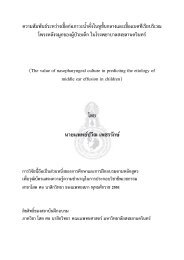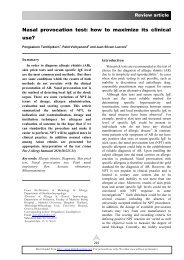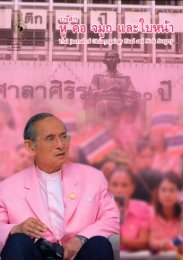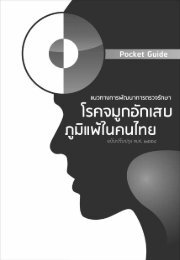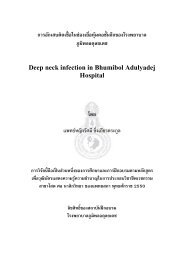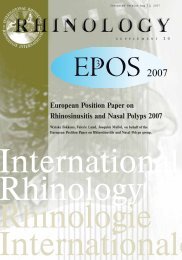Download - ราà¸à¸§à¸´à¸à¸¢à¸²à¸¥à¸±à¸¢ à¹à¸ªà¸ ศภà¸à¸²à¸ªà¸´à¸à¹à¸à¸à¸¢à¹ à¹à¸«à¹à¸à¸à¸£à¸°à¹à¸à¸¨à¹à¸à¸¢
Download - ราà¸à¸§à¸´à¸à¸¢à¸²à¸¥à¸±à¸¢ à¹à¸ªà¸ ศภà¸à¸²à¸ªà¸´à¸à¹à¸à¸à¸¢à¹ à¹à¸«à¹à¸à¸à¸£à¸°à¹à¸à¸¨à¹à¸à¸¢
Download - ราà¸à¸§à¸´à¸à¸¢à¸²à¸¥à¸±à¸¢ à¹à¸ªà¸ ศภà¸à¸²à¸ªà¸´à¸à¹à¸à¸à¸¢à¹ à¹à¸«à¹à¸à¸à¸£à¸°à¹à¸à¸¨à¹à¸à¸¢
You also want an ePaper? Increase the reach of your titles
YUMPU automatically turns print PDFs into web optimized ePapers that Google loves.
3<br />
Abstract<br />
Objective : To study the association between facial pain and the prevalence of anatomical variation of the<br />
nasal cavity and paranasal sinus.<br />
Design : Retrospective Case - Control Study<br />
Methods : CT paranasal sinus scans and medical records, obtained from adult patients undergoing<br />
evaluation at Maharaj Nakorn ChiangMai Hospital from 1 st January 2001 to 31 st May 2008, were reviewed.<br />
There were 26 patients in the facial pain group and 60 patients in the nonfacial pain. The controlled group<br />
of non facial pain patients were underwent CT scan for non rhinologic diagnosis.The patients with<br />
previous sinus surgery, facial trauma, sinusitis, nasal cavity and paranasal sinus tumors or polyps, and<br />
Lund score > 4 were excluded. The prevalence of each bony anatomical variation was compared.<br />
Data was analyzed using SPSS program version 11.0 : Chi-square test, Fisher’s exact test, t-test, Mann-<br />
Whitney test, p-value, and Odd ratio.<br />
Result : The prevalence of anatomical variation of the nasal cavity and paranasal sinus in facial pain<br />
group (26 patients) were 69.2% of Agger nasi cells, 57.7% of concha bullosa of middle turbinate, 53.8%<br />
of Onodi cells, 30.8% of supreme turbinate, 26.9% of Haller cell, 23.1% of concha bullosa of superior<br />
turbinate, 15.4% of contact deviated nasal septum, 7.7% of paradoxical middle turbinate, and there was no<br />
double middle turbinate found. In the non facial pain group (60 patients), the concha bullosa of middle<br />
turbinate were presented in 60%, Onodi cells 56.7%, Agger nasi cells 53.3%, Haller cell 28.3%, concha<br />
bullosa of superior turbinate 23.3%, paradoxical middle turbinate 6.7%, supreme turbinate 6.7%, double<br />
middle turbinate 3.3%, and contact deviated nasal septum 1.7%. Most of the presented bony anatomical<br />
variations between the two groups showed no significant difference, except the deviated nasal septum<br />
were significantly more common in the facial pain groups than the non facial pain group (p = 0.046 )<br />
(95% CI 1.136 – 101.304).



